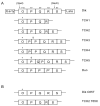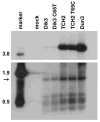A system for the analysis of BKV non-coding control regions: application to clinical isolates from an HIV/AIDS patient
- PMID: 20869740
- PMCID: PMC2957895
- DOI: 10.1016/j.virol.2010.08.032
A system for the analysis of BKV non-coding control regions: application to clinical isolates from an HIV/AIDS patient
Abstract
The human polyomavirus BK virus (BKV) is an important opportunistic pathogen whose disease prevalence continues to increase with the growing immunocompromised population. To date, the major determinant of replication in cell culture has not been formally proven. BKV exists as archetype virus and rearranged variants, which are classified based on the DNA sequence of their non-coding control regions (NCCRs). The archetype BKV NCCR is divided into five blocks of sequence and rearranged variants contain deletions and duplications of these blocks. In this study, a genetic system was developed and used to identify the major determinant of replication ability in primary renal proximal tubule epithelial cells, the natural host cell of BKV. This system was also used to analyze NCCR variants isolated from an immunocompromised patient which contain assorted rearrangement patterns and functional differences. This study solidifies the NCCR as the major genetic determinant of BKV replication ability in vitro.
Copyright © 2010 Elsevier Inc. All rights reserved.
Figures




Similar articles
-
Functional analysis of polyomavirus BK non-coding control region quasispecies from kidney transplant recipients.J Med Virol. 2009 Nov;81(11):1959-67. doi: 10.1002/jmv.21605. J Med Virol. 2009. PMID: 19774689
-
Unique BK virus non-coding control region (NCCR) variants in hematopoietic stem cell transplant recipients with and without hemorrhagic cystitis.J Med Virol. 2006 Apr;78(4):485-93. doi: 10.1002/jmv.20566. J Med Virol. 2006. PMID: 16482558
-
Polyomavirus BK with rearranged noncoding control region emerge in vivo in renal transplant patients and increase viral replication and cytopathology.J Exp Med. 2008 Apr 14;205(4):841-52. doi: 10.1084/jem.20072097. Epub 2008 Mar 17. J Exp Med. 2008. PMID: 18347101 Free PMC article.
-
Noncoding control region of naturally occurring BK virus variants: sequence comparison and functional analysis.Virus Genes. 1995;10(3):261-75. doi: 10.1007/BF01701816. Virus Genes. 1995. PMID: 8560788 Review.
-
Different behaviour of BK-virus infection in liver transplant recipients.World J Gastroenterol. 2016 Jan 28;22(4):1532-40. doi: 10.3748/wjg.v22.i4.1532. World J Gastroenterol. 2016. PMID: 26819520 Free PMC article. Review.
Cited by
-
Tumor Necrosis Factor-Alpha Inhibits the Replication of Patient-Derived Archetype BK Polyomavirus While Activating Rearranged Strains.J Med Virol. 2025 Feb;97(2):e70210. doi: 10.1002/jmv.70210. J Med Virol. 2025. PMID: 39949253 Free PMC article.
-
Establishment of a Stable BK Polyomavirus-Secreting Cell Line: Characterization of Viral Genome Integration and Replication Dynamics Through Comprehensive Analysis.Int J Mol Sci. 2025 Jun 15;26(12):5745. doi: 10.3390/ijms26125745. Int J Mol Sci. 2025. PMID: 40565208 Free PMC article.
-
The prevalence and isolated subtypes of BK polyomavirus reactivation among patients infected with human immunodeficiency virus-1 in southeastern China.Arch Virol. 2018 Jun;163(6):1463-1468. doi: 10.1007/s00705-018-3724-y. Epub 2018 Feb 12. Arch Virol. 2018. PMID: 29435709 Free PMC article.
-
Sirolimus and Other Mechanistic Target of Rapamycin Inhibitors Directly Activate Latent Pathogenic Human Polyomavirus Replication.J Infect Dis. 2021 Oct 13;224(7):1160-1169. doi: 10.1093/infdis/jiaa071. J Infect Dis. 2021. PMID: 32060513 Free PMC article.
-
Biology of Polyomavirus miRNA.Front Microbiol. 2021 Apr 6;12:662892. doi: 10.3389/fmicb.2021.662892. eCollection 2021. Front Microbiol. 2021. PMID: 33889147 Free PMC article. Review.
References
-
- Chesters PM, Heritage J, McCance DJ. Persistence of DNA sequences of BK virus and JC virus in normal human tissues and in diseased tissues. J Infect Dis. 1983;147:676–84. - PubMed
-
- Cubukcu-Dimopulo O, Greco A, Kumar A, Karluk D, Mittal K, Jagirdar J. BK virus infection in AIDS. Am J Surg Pathol. 2000;24:145–9. - PubMed
-
- de Villiers J, Schaffner W, Tyndall C, Lupton S, Kamen R. Polyoma virus DNA replication requires an enhancer. Nature. 1984;312:242–6. - PubMed
Publication types
MeSH terms
Substances
Grants and funding
LinkOut - more resources
Full Text Sources
Other Literature Sources
Medical

